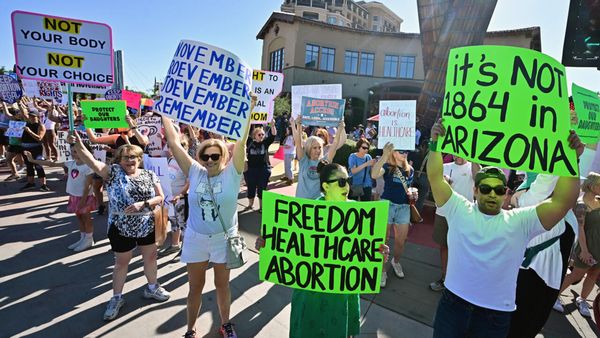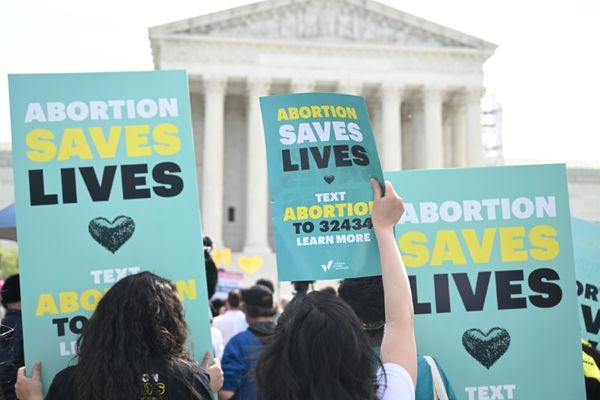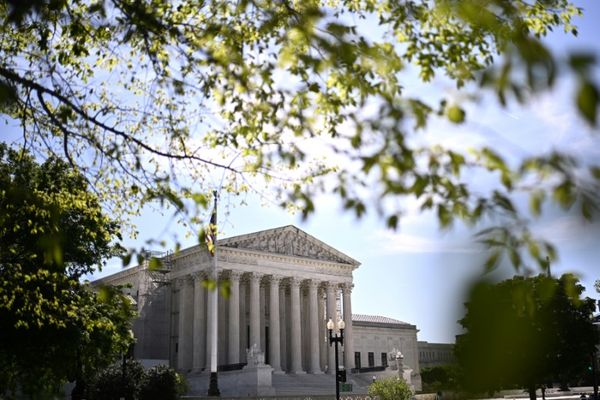/media/img/mt/2022/06/image_6/original.png)
MILWAUKEE—On a rainy Tuesday afternoon in May, I visited the evangelical pastor Marty Calderon at God Touch, his church in Milwaukee’s Lincoln Village neighborhood. A gentle, quiet presence, Calderon has become one of the most sought-after Latino endorsers for Republican office seekers in Wisconsin, having spent years working to build Latino support for the GOP here. It hasn’t been easy. Until recently, to his great frustration, national Republicans all but ignored Milwaukee and its Latino population, he says.
But these days, Calderon is at least “cautiously optimistic.” In 2020, the Trump campaign opened an office on Milwaukee’s historically Latino South Side, doling out signs and selling Latinos for Trump hats; Calderon offered a prayer that year at the start of a Trump rally in Waukesha. Last September, the Republican National Committee set up a Hispanic community center in Milwaukee, along with others in South Florida and Texas’s Rio Grande Valley. And in April, the National Republican Senatorial Committee announced a seven-figure initiative—“Operación ¡Vamos!,” or “Operation Let’s Go!”—to court Latino voters in Wisconsin and eight other swing states.
The immediate goal is to build on growing Latino support for the GOP through ground-level outreach ahead of the midterm elections this fall. The efforts are still in their early stages. “If the Republican Party stays true to its word and stays long-term, things could change,” Calderon told me, with a note of skepticism. But the trend lines among Latino voters suggest that Democrats should be worried about losing Latino support—not just in Texas or Florida, the usual states for Latino outreach, but across the country, including here in the Midwest.
The Republican Party’s Wisconsin outreach is part of a larger push to capitalize on former President Donald Trump’s 10-point gain among Latino voters from 2016 to 2020, and attract more of those voters to the GOP in the long run. If it comes to pass, the Latino “awakening” in Wisconsin could mean the defeat of Democratic Governor Tony Evers and the reelection of Republican Senator Ron Johnson, who are both expected to face tight races this fall. More broadly, Latino voters in Wisconsin represent the coming together of two of the most important themes in U.S. politics over the past decade: the fight over Rust Belt states that have gone from blue to purple, and the growing importance of the Latino vote. In Wisconsin, these conversations are one and the same.
[Geraldo L. Cadava: There’s no such thing as the ‘the Latino vote’]
The Latino population in Wisconsin, like in just about everywhere else around the country, is on the rise. In the 2020 U.S. census, Latinos for the first time were Wisconsin’s largest minority group, making up 7.1 percent of the population, up from 5.9 percent in 2010. The growth rate of the Latino population from 2010 to 2020 was nearly 10 times faster than that of the state’s overall population. They live all over the state but many are concentrated in Milwaukee, where a population decline over the past decade has been mitigated by the growth of both the Latino and the Asian communities. Political scientists note that Latino political participation lags behind population growth, because many new arrivals are too young to vote, are not citizens, or are not engaged in politics. But that will change.
Trump’s improved performance among Latinos has been well documented in places such as South Florida and South Texas, but something similar happened in other regions. In Wisconsin, exit polls reported that Trump won 34 percent of the Latino vote in 2016 and 37 percent in 2020. An election-eve poll from the Latino-run firm Latino Decisions also showed a shift in Wisconsin, from 10 percent Latino support for Trump in 2016 to 22 percent in 2020. According to John Johnson, a research fellow at Marquette University, Milwaukee’s heavily Latino South Side moved more toward Trump than any other part of the city. In 2016, Trump won 16.2 percent of the vote in Milwaukee’s majority-Latino wards, and Hillary Clinton won 79.5 percent. In 2020, Trump won 21.8 percent of the vote in those wards, and Joe Biden won 76.6 percent. (Biden won Wisconsin overall, by about 20,000 votes.)
Republican outreach to Latinos in this state isn’t entirely new. Groups such as the LIBRE Initiative, a Koch-funded organization that promotes free enterprise within Latino communities, began operating in Wisconsin in the early 2010s, running ESL programs and helping Latinos find a second job or start their own business. Aldira Aldape, who has spent the past several years working on immigration, criminal justice, and economic issues for another Koch group, Americans for Prosperity, in Wisconsin, told me that her parents—Mexican immigrants who worked in agriculture, trucking, and cosmetology—taught her the importance of financial independence. As a young adult, she concluded that the Republican Party offered her the best chance at “prosperity,” and she believes this is true for other Latinos too.
Daniel Garza, the president of the LIBRE Initiative, told me that Republicans’ economic agenda should have even more appeal to Latino voters today, in Wisconsin and around the country. The GOP, he said, is listening to what Latinos say they want—lower gas prices, less inflation, deregulation, and fewer restrictions on oil and gas production and the jobs that come with it. Democrats, Garza argued, are trying to impose on Latinos their ideas about a multitude of issues, including climate change and what kinds of speech should be protected.
Verónica Díaz, who ran as a Republican candidate for the Wisconsin state legislature in 2020, points to other issues where Latinos here have found common ground with Republicans. Díaz told me that during her campaign, voters on Milwaukee’s South Side repeatedly asked her “Por que eres republicana?”—“Why are you a Republican?” She shared with them her views on religion, abortion, policing, business, and school choice. (Charter schools and schools with voucher programs account for almost 60 percent of Milwaukee schools that are 70 percent Latino or higher, and the city, which passed its first voucher program in 1990, has been a kind of laboratory for school choice.) Díaz, who had Calderon’s backing in her race, also argued that Democratic control of city politics over the past several decades was responsible for poverty, rising crime rates, and failing public schools. She lost her race by a long shot but said she believes Latino voters were more receptive to her message than they would have been in the past.
Progressives and other Democrats traditionally have relied on their positions on immigration and racial justice to attract Latino voters. Christine Neumann-Ortiz, the executive director of Voces de la Frontera, a Wisconsin-based nonpartisan organization that advocates for workers’ and immigrants’ rights, told me she was surprised that so many Latinos would support the “cruel and racist” Trump. She argues that in order to consolidate Latino support, Democrats need to do more on immigration: Get rid of programs that deputize local law-enforcement officers to enforce federal immigration laws; end federal contracts with private detention centers; take a strong stand against Title 42, the federal policy restricting immigration on account of the pandemic; and pass an immigration-reform bill with a pathway to citizenship. The Democratic Party needs more progressives, Neumann-Ortiz argued, not Democrats who will “chase the coattails of the far-right, white-nationalist politicians.” Otherwise, they risk the possibility that Latinos could stay home on Election Day, disillusioned by promises made and broken.
Neumann-Ortiz’s views are bolstered by a recent Axios-Ipsos Latino Poll, conducted with Noticias Telemundo, that found that a strong majority of Latinos across the country favor a pathway to citizenship for all undocumented immigrants living in the United States, and asylum for migrants fleeing crime and violence in Latin America. But in the same poll, as well as other opinion surveys over the years, Latinos consistently report caring more about health care, crime, climate change, and inflation than they do about immigration. Immigrant-rights advocates such as Neumann-Ortiz note that immigration isn’t a stand-alone issue but is often inseparable from others. Still, it is difficult to draw conclusions about partisan preference based on survey findings, because liberal and conservative policies on each issue appeal to different segments of the Latino population.
Democrats and advocacy groups such as Voces de la Frontera argue that programs like the RNC community centers and Operación ¡Vamos! are largely for show, and do not really demonstrate Republican care for Latino concerns. When I visited the RNC community center in Milwaukee, it was sleepy—just me and a lone worker there, a young Black man from Arkansas who had moved to Kenosha to do Republican outreach before the 2020 election and then moved to Milwaukee to help mobilize Republicans this year and in 2024. He told me that I happened to visit during a lull between Milwaukee’s special mayoral election in April and the summer months, when GOP organizers would gear up again for Wisconsin’s August primary. I took some pictures of the signs in the windows, pocket Constitutions published in Spanish, bumper stickers promoting conservative candidates and causes, and bookshelves stocked with conservative titles and topped with a ceramic family of elephants. With no one else to talk with, I left.
But Preya Samsundar, the Midwest regional communications director for the RNC, told me that the center in Milwaukee has been active since it opened, hosting candidate meet-and-greets, panels with community leaders, and food and toy drives. Such activities are part of what Jaime Florez, the Hispanic communications director for the RNC, described as the “two-way relationship” the centers aim to establish with Latino communities: encouraging partisan allegiance while listening to Latino voters about what they think the Republican Party should do. The community centers are already succeeding, Florez argued, as demonstrated by the Republican candidate Mayra Flores’s recent victory in a special congressional election in Texas’s Rio Grande Valley; an RNC Hispanic community center opened in the area last October.
Juan Arias, the Hispanic press secretary for the NRSC, disputes the notion that the GOP’s efforts in Wisconsin are merely symbolic. He told me that Operación ¡Vamos! represents the nationalization of what Rick Scott did as governor of Florida. Long before becoming the chair of the NRSC and launching the Hispanic-outreach initiative, Scott built relationships with Hispanic voters in his state; in his 2018 Senate campaign, almost half of all of Florida’s Latino voters cast their ballot for him. Arias said Republicans are hoping to build on a shift that’s already under way—as demonstrated not only by Latinos’ drift toward Trump in 2020 but also by the NRSC’s own surveys of Latino voters. In the months ahead, Arias said, the NRSC is also preparing to run radio and television ads in Spanish in battleground states.
[Read: Are Iowa’s Democratic days gone for good?]
I expect Republican Party initiatives such as the RNC community centers and Operación ¡Vamos! will have at least some effect in Milwaukee’s Latino community, and possibly even Wisconsin’s elections this year. But Democrats should recognize that these efforts are significant regardless, representing a real sense of disillusionment that many Latino voters feel with the Democratic Party. Democrats shouldn’t assume that they will earn Latino support if their candidates support progressive immigration policies, or just show up to talk with Latino voters. They must also convince Latinos in Milwaukee and across the United States that Democratic policies on issues including education, the economy, and policing will measurably improve Latinos’ lives.
Of course, either party can fall prey to complacency. Despite Calderon’s cautious optimism these days, he is also nervous. Latinos here in Milwaukee are interested in long-term investment in their community, he told me, not the temporary operations that leave right after election season. Arias said that, at least as long as Scott is NRSC chair, the senator “will continue to advocate for aggressive outreach to the Hispanic community.” Florez said he couldn’t say for sure whether the RNC community centers would stay open, though he believes they should. If the Republican Party fails to keep engaging Latinos in Wisconsin after the midterms, Calderon said, it will feel like another “punch in the mouth.”







